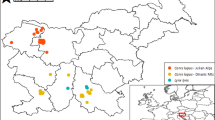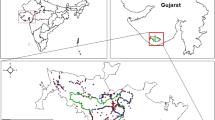Abstract
To derive a model which allows estimating eaten prey masses from lynxLynx lynx Linnaeus, 1758 scats, we fed 3 roe deerCapreolus capreolus, 2 wild boarsSus scrofa, 1 fallow deerDama dama, 1 mouflonOvis ammon musimon, 1 European hareLepus europaeus and 1 daily diet of miceMus musculus to two adult lynx. The percentage of prey use decreased with an increase in the offered body mass of the prey individual. Conversion factors from dry matter scat mass to fresh matter mass of eaten prey (y) increased linearly as the eaten mass of the prey individual (x) rose:y = 15.06 + 1.330x,R 2 = 0.643,F 1,7 = 12.6,p < 0.01. For estimating eaten prey masses from lynx scats we recommend to use (1) this equation as well as (2) prey type-specific conversion factors and (3) prey type-specific quotients of the eaten prey mass per scat.
Similar content being viewed by others
References
Anders O. and Sacher P. 2005. Das Luchsprojekt Harz — ein Zwischenbericht. Nationalpark-Forum 7/05: 4.
Breitenmoser U. and Haller H. 1987. Zur Nahrungsökologie des Luchses (Lynx lynx) in den schweizerischen Nordalpen. Zeitschrift für Säugetierkunde 52: 168–191.
Breitenmoser U. and Haller H. 1993. Patterns of predation by reintroduced European lynx in the Swiss Alps. The Journal of Wildlife Management 57: 135–144.
Burmester T. 2005. Zur Ontogenese handaufgezogener Luchse (Lynx lynx Linné 1758) unter besonderer Berücksichtigung der körperlichen Entwicklung und des Fortpflanzungs-verhaltens. Cuvillier Verlag Göttingen: 380.
Eisfeld D. 1978. Das Reh als Beutepotential des Luchses. [In: Der Luchs — Erhaltung und Wiedereinbürgerung in Europa. Luchsgruppe, ed]. Morsak Verlag, Grafenau: 81–87.
Floyd T. J., Mech L. D. and Jordan P. D. 1978. Relating wolf scat content to prey consumed. The Journal of Wildlife Management 43: 528–532.
Gil-Sánchez J. M., Ballesteros-Duperón E., Bueno-Segura J. F. 2006. Feeding ecology of the Iberian lynxLynx pardinus in eastern Sierra Morena (Southern Spain). Acta Theriologica 51: 85–90.
Goszczyński J. 1974. Studies on the food of foxes. Acta Theriologica 19: 1–18.
Haglund B. 1966. Winter habits of the lynx (Lynx lynx L.) and wolverine (Gulo gulo L. ) as revealed by tracking in the snow. Viltrevy 4: 81–310.
Haller H. 1992. Zur Ökologie des Luchses (Lynx lynx) im Verlauf seiner Wiederansiedlung in den Walliser Alpen. Mammalia depicta 15. Paul Parey Verlag, Hamburg: 1–62.
Hell P. 1973. Ergebnisse der Luchsforschung in der CSSR. Beiträge zur Jagd- und Wildforschung 8: 335–344.
Hemmer H. 1993.Felis (Lynx) lynx Linnaeus 1758. [In: Handbuch der Säugetiere Europas, Vol. 5/II (J. Niethammer and F. Krapp, eds]. Aula Verlag Wiesbaden 1071: 1119–1167.
Henneberg W. and Stohmann F. 1864: Beiträge zur Begründung einer rationellen Fütterung der Wiederkäuer. Vol. 2. Schwenke und Sohn, Braunschweig: 1–205.
Hucht-Ciorga I. 1988. Studien zur Biologie des Luchses: Jagdverhalten, Beuteausnutzung, innerartliche Kommunikation und an den Spuren fassbare Körpermerkmale. Ferdinand Enke Verlag Gießen: 1–177.
Hucht-Ciorga I. and Müller H.-C. 2005. Impact of landscape heterogeneity on European lynx (Lynx lynx) habitat use and predation in the Bavarian Forest and the Swiss Alps. [In: XXVIIth Congress of the International Union of Game Biologists. K. Pohlmeyer, ed]. Hannover, Germany: 113–114.
Jędrzejewski W., Schmidt K., Miłkowski L., Jędrzejewska B. and Okarma H. 1993. Foraging by lynx and its role in ungulate mortality: the local (Białowieża Forest) and the Palaearctic viewpoints. Acta Theriologica 38: 385–403.
Jędrzejewska B. and Jędrzejewski W. 1998. Predation in vertebrate communities. Springer Verlag Berlin and Heidelberg: 1–450.
Jonsson S. 1980. Erforschung und Erhaltung des Luchses in Schweden. [In: Der Luchs in Europa. A. Festetics, ed]. Kilda Verlag, Greven: 170–180.
Kozlo P. G. 2003. Byelorussia. [In: The lynx. E. N. Matyushkin and M. A. Vaisfeld, eds]. Nauka Moscow: 134–137.
Lehmann F. 1890. Bericht über die Thätigkeit der Versuchsstation Weende-Göttingen. Jahrbuch für Landwirtschaft, XXXVIII. Jahrgang: 435–461.
Lockie J. D. 1959. The estimation of the food of the foxes. The Journal of Wildlife Management 23: 224–227.
Matjushkin E. N. 1978. Der Luchs. Neue Brehm-Bücherei Nr. 517, A. Ziemsen Verlag, Wittenberg-Lutherstadt: 1–160.
Okarma H. 1984. The physical condition of red deer falling to prey to the wolf and lynx and harvested in the carpathian mountains. Acta Theriologica 29: 283–290.
Okarma H., Jędrzejewska B., Jędrzejewski W., Krasiński A. and Miłkowski L. 1995. The roles of predation, snow cover, acorn crop, and man-related factors on ungulate mortality in Białowieża Forest, Poland. Acta Theriologica 40: 197–217.
Okarma H., Jędrzejewski W., Schmidt K., Kowalczyk R. and Jędrzejewska B. 1997. Predation of Eurasian lynx on roe deer and red deer in Białowieża Primeval Forest, Poland. Acta Theriologica 42: 203–224.
Ruehe F., Buschmann I., Wameling A. 2003. Two models for assessing the prey mass of European ungulates from wolf scats. Acta Theriologica 48: 527–537.
Traves J. L. 1983. An assessment of quantity of prey consumed by wolves through analysis of scats. Master of Arts Thesis, Northern Michigan University, Marquette: 1–32.
Valdmann H., Andersone-Lilley Z., Koppa O., Ozolins J. and Bagdrade G. 2005. Winter diets of wolfCanis lupus and lynxLynx lynx in Estonia and Latvia. Acta Theriologica 50: 521–527.
Weaver L. L. 1993. Refining the equation for interpreting prey occurrence in grey wolf scat. The Journal of Wildlife Management 57: 534–538.
Zheltukhin A. S. 2003. The Center of the Russian Plain. [In: The lynx. E. N. Matyushkin and M. A. Vaisfeld, eds]. Nauka, Moscow: 166–167.
Author information
Authors and Affiliations
Corresponding author
Additional information
Associate editor was Krzysztof Schmidt.
Rights and permissions
About this article
Cite this article
Rühe, F., Burmester, T. & Ksinsik, M. Data for estimating eaten prey masses from Eurasian lynxLynx Lynx scats in Central and East Europe. Acta Theriol 52, 317–322 (2007). https://doi.org/10.1007/BF03194228
Received:
Accepted:
Issue Date:
DOI: https://doi.org/10.1007/BF03194228




